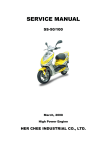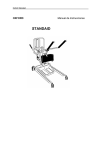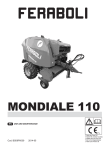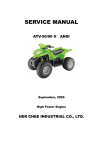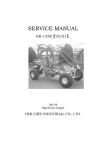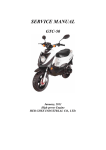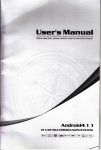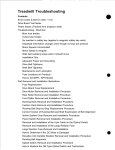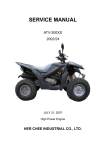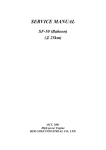Download SERVICE MANUAL
Transcript
SERVICE MANUAL RT-50 January 2008 High power Engine HER CHEE INDUSTRLAL CO., LTD. INTRODUCTION This Service Manual is provided as the technical information for the check & preparation of ADLY RT-50 scooter, and the direction edited is given in diagrams with "Operation Sequence", "Key Points", and "Adjustment of Check" for reference of the service staffs. This Service Manual is finished in accordance with the model of RT-50. Taking new model as standard if there are differences between the models described in this manual and the actual scooter. HER CHEE INDUSTRIAL CO., LTD. CONTENTS Chapter 01 Chapter 1 INFORMATION FOR PREPARATION………… Chapter 02 CHECK AND ADJUST…………………………………………. Chapter 03 ENGINE REMOVAL……………………………………………. Chapter 04 CYLINDER HEAD / CYLINDER / PISTON………………….. Chapter 05 CRANK CASE & CRANK SHAFT……………………………. Chapter 06 Transmission…………………………………………………… Chapter 07 Final Transmission Mechanism…………………………….. Chapter 08 Fuel System………………………………………………......... Chapter 09 Front Wheel / Front Suspension / Front Brake…………… Chapter 10 Rear Wheel / Suspension / Brake…………………………… Chapter 11 Electrical Device……………………………………………….. 1 Chapter 1 Information for Preparation Attention on Operation z All washers, oil rings, clamp rings, opening pins shall be duly replaced by a new item when dismounted. z Locking of all screws, nuts, cross screws shall be performed in the order of first the large screws and then the small ones and from inside to outside in opposite angles by tightening the torque locks. z All items must use original parts, pure oil and greases. z All service shall use special tools and general tools to repair. z All dismounted items requiring for checks shall be duly cleaned and for assembly, all items shall be duly lubricated. Chapter 1 Information for Preparation Attention on Operation z Certified lubricants in cans shall be used on all the elements to be lubricated. z After assembly, performance of all elements shall be duly checked and the locking shall be duly verified. z In case of an operation is performed by over 2 people, the assignment shall be conducted in coordination and safety shall be the first priority. z Definition of signs: The sign given in the Service Manual shall refer to the operation methods and observation. OIL: Lubrication by designated lubricant. GREASE: Lubrication by grease Special Tool: Parts on which special tools shall be used General Tool: General tools shall be used New: Replace by new items after dismounting Attention Dangerous and important operations Chapter 1 Information for Preparation SPECIFICATION TYPE RT 50 LENGTH 1585mm WIDTH 700 mm HEIGHT 960 mm WHEEL BASE 1070 mm NET WEIGHT ENGINE TYPE 2-STROKE, Single Cylinder COOLING AIR COOLED DISPLACEMENT 49.26 C.C. BORE×STROKE 40.0×39.2 COMPRESSION RATIO 7.2:1 IGNITION C.D.I STARTER ELECTRIC / KICK SUSPENSION Hydraulic Shock Absorber TRANSMISSION TIRE FRONT/REAR AUTOMATIC Front 120/90-10 (Option Rear 120/90-10 (Option FRONT BRAKE Disc REAR BRAKE Drum Chapter 1 Information for Preparation LOCKING TORQUE Adopt the standard torque locking for the item unlisted. STANDARD TORQUE: Type 5 mm Screw 6 mm Screw 6 mm Hex Washer Face Bolt / Nut 8 mm Hex Washer Face Bolt / Nut 10 mm Hex Washer Face Bolt / Nut Locking Torque (kg-m) 0.4 1.0 1.2 2.7 4.0 CHASSIS: Locking Place Quantity Dia. (mm) Spanner Nut of Handle Steering 1 25 Steam Front Wheel Axle Nut 1 10 Rear Axle Nut 1 14 Rear Brake Arm Screw 1 5 Upper Screw of Rear Shock Absorber 1 10 Lower Screw of Rear Shock Absorber 1 8 Engine Mounting Bracket 1 8 Locking Torque (kg-m) 7.0 4.5 11 0.6 4.0 2.7 6.0 ENGINE: Locking Place Screw of Cylinder Cap Flywheel Nut Clutch Jacket Nut Driving Disc Nut Nut of Transmission Disc Oil-check Screw Joint Screw of Exhaust Manifold Exhaust Pipe Support Screw of Muffler Spark Plug Bolt of Crank Shaft Case Bolt of Engine Installation Chapter 1 Quantity Dia. (mm) 4 1 1 1 1 1 2 2 6 10 11 28 10 8 6 6 Locking Torque (kg-m) 1.0 3.8 3.8 5.5 3.8 1.3 1.2 1.2 1 6 1 14 6 8 1.4 10 5.0 Information for Preparation The following drawing that shows the disassembling situation of the cover parts for RT50 scooter. Chapter 1 Information for Preparation INFORMATION FOR PREPARATION REVOLUTION NOT STABLE (LOW R.P.M.) Diagnose Check and Adjust Reason of Trouble ignition timing adjusting normal C.D.I damage pulser coil damage abnormal adjust the carburetor fuel adjuste screw adjusting is correct mixture gases too lean (loosing screw) mixture gases too rich (locking screw) adjusting isn't correct carburetor sucking air no sucking air sucking air loosen spark plug, connecct with spark cap and contract with frame, check the spark plug sparking ? sparking normal sparking abnormal gasket damage the screw of carburetor is loosen (-) pressure tube broken spark damage or stain C.D.I damage A.C.G damage coil damage spark plug cable damage odr short main switch damage check A.C.G normal end abnormal A.C.G damage air hole damage or blocking (-) pressure tube damage Chapter 1 Information for Preparation INFORMATION FOR PREPARATION REVOLUTION NOT SMOOTH(HIGH SPEED) Check and Adjust Diagnose Reason of Trouble adjusting ignite timeing normal C.D.I damage ACG pulse coil damage abnormal adjusting valve gap normal adjusting isn't correct valve set damage abnormal check fuel cup supply normal ? normal fule filter blocking air hole of fuel tank blocking fuel cup damage fuel of tank is too less abnormal carburetor blocking cleaning no blocking blocking check and adjust valve timing valve timing is correct camshaft gear mark position is not correct valve timing isn't correct check the spring of valve normal end spring broken or elastic deformation spring damage Chapter 1 Information for Preparation INFORMATION FOR PREPARATION CHARGE ABNORMAL Check and Adjust Diagnose Reason of Trouble start engine and measure voltage of the two terminal for battery voltage of battery can't go up voltage of battery is normal battery damage measure the resistance of ACG coil coil damage terminal damage YL wire damage measure value too high normal check the regulator battery have voltage battery have not voltage R wire damage check socket of regulator loosen ? normal regulator damage socket damage abnormal ACG damage (over charge) check the voltage between regulator and frame main switch at ON the battery have voltage main switch at ON the battery have no voltage GR wire broken check the socket of regulator normal socket loosen socket damage regulator damage Chapter 1 Information for Preparation INFORMATION FOR PREPARATION SPARK PLUG NO SPARKING Check and Adjust Diagnose Reason of Trouble change spark plug and check again no sparking or weak the previous spark plug damage sparking strong check spark plug, cap, ignition coil loosen? loosen no loosen spark plug cap loosen check C.D.I unit socket loosen ? normal abnormal socket damage check the terminal of C.D.I unit unimpeded? measure resistance abnormal normal check relate spare parts normal main switch damage pulser coil damage coil damage lighten coil damage abnormal main switch damage socket, joint connect abnormal change CDI unit normal the previous C.D.I unit damage abnormal change ignition coil abnormal the previous coil damage Chapter 2 Check and Adjust Way of Check & Adjustment 1. Mark “○” is checking time. 2. Mark “☆” is the regular exchange of service items. This exchange time is just for general riding of the majority not for the special use, please arrange with this principle according to the difference of the riding condition. Service Items Service Time (month) Before riding 1st each 6 each 12 Judgment Standard Remarks Operating Device Handle- Play, loose/tight ○ Operation ○ Wheels- Right/left turn round angle ○ Front Fork-Damage ○ ○ Direction Post Installation of shaft ○ ○ Direction Post Shaft Gap ○ Brake Device Brake- Play Try to run ○ Correct brake ○ Wires- Loose / tight and damage ○ ○ ○ ○ ○ ○ ○ ○ ○ ○ ○ ○ Gap of casing & brake Wore of brake & operating parts Play of brake lever 10-20 mm ○ Wore & Damage of casing Direction Standard diameter ○ Limitation ○ ○ ○ Check and Adjust 2-1 rear 1.50 kg/cm2 1.75 kg/cm2 Air pressur e tire Chapter 2 110.5mm front Riding Device Tires-Air pressure of tires 110 mm 120/90-10 130/90-10 Service Items Service Time (month) Judgement Standard Before 1st each 6 each 12 riding Remarks Riding Device Tires Check & damage of tires Abnormal & ditch in tires Bolt & nut of tires locking ○ ○ Damage of wheels ,disc ○ ○ ○ ○ ○ ○ ○ ○ ○ Tightness of front bearing Tightness of rear bearing Suspension device Spring -damage ○ ○ Suspension arm – damage of joint gap & arm Tightness of installation ○ Ditch-front and rear wheel till 0.8 mm Flocking torsion Front wheel – 4.0~5.0 kg-m Rear wheel –10~12 kg-m Vibration of wheel Front wheel – horizontal under 3 mm, vertical under 3 mm, Rear wheel – horizontal under 3 mm, vertical under 3 mm ○ Spring of shock absorber ○ Power transmission device Clutch -action Crankcase oil leakage or damage Transmission gear oil ○ ○ ○ ○ ○ ○ ○ ○ Electric device Ignition device -condition of ignition spark plug Battery -connection of terminal Wiring of electrical appliance – damage or loose in connection place Chapter 2 ○ ○ Check and Adjust 2-2 Gap of spark plug 0.6~0.7 mm Service Items Service Time (month) Judgement Standard Before 1st each 6 each 12 riding Engine ○ Body – starting & abnormal noise low speed & accelerating exhaust air filter ○ Idle : 1800±100 rpm ○ ○ ○ ○ ○ ○ ○ ○ ○ ○ ○ Lubrication device Oil and oil filter Oil leakage Warning light lighting Fuel installation Gasoline filter is dirty Leakage of fuel Throttle gate & choke Fuel filter is clogged Oil level Alteration of pipes ○ ○ ○ ○ ○ ○ each 2 years Lights & direction lights Action On/off normal , dirty , damage Rear view mirror Instrument –action ○ ○ ○ ○ ○ ○ Exhaust pipe & muffler Installation loosed or damage Function of muffler Frame & body –loose or damage Abnormal from previous day –confirm normal Others- greasing of each part Cleaning combustion chamber , exhaustpipe , and carbon muck in muffler Chapter 2 ○ ○ ○ ○ ○ ○ ○ Check and Adjust 2-3 Remarks Disassembly of External Parts Remove the external parts for checking and adjustment Read cover separate the join with the chassis (the * Open the seat. concave and the convex) and remove * Remove the 2 hex-nuts, 1 bolt to the front cover. remove the luggage rack. * Remove the main switch cap. * Remove 10 self-tapping screws and 2 * Follow the sequence in reverse order round-headed bolts.. for assembly. * Remove the central and body cover ATTENTION: * Install with reverse sequence. - Be sure the joint of front cover and ATTENTION: cowling jointing correctly before - Please do keep away the unit of the tie-up the screws and nuts. body and the pedal from damages. - Before tightening the screws, be Tail light assembly sure of correct matching of all units. * Remove 2 hex bolts and rear fender assembly. * Remove the left and right body Cowling covers. * Remove 4 tapping screws and 2 * Remove 2 hex bolts and the tail light round-head bolts. assembly. * Separate the joint of inner parts and * Follow the mounting sequence in remove the cowling. reverse order. * Install with reverse sequence. ATTENTION: - Match the rear guard holes and the Front Cover convex of the chassis. * Remove 4 tapping screws and 3 hexnuts. * Separate the joint of inner parts and Handle covering remove the cowling. * Remove the rear mirror * Install with reverse sequence. * Remove 3 tapping screws, separate ATTENTION: the joint from the handle rear cover - Be sure of not damaging the front and remove the cover. pane land the front inner union (the * Dismantle the speedometer cable convex and concave portions). adapter. - While tightening the screws, be sure * Remove the speedometer and head of the matching with the luggage light assembly. case. * Dismantle the handle switch wiring. Floor panel * Follow the reverse sequence for ass’y * Remove the L/R side cover and body ATTENTION: cover. - Matching the joint of handle cover * Remove 4 hex bolts. with the head light case. * Separate the front interior covering Load the cables and wires joint (the claw and the groove) and accordingly. remove the pedal. - After the assembly, check the * Follow the sequence in reverse order function of all switches. for assembly. ATTENTION: - After joining the pedal and the front Adjustment of the head light interior covering, mount it onto the chassis. * Adjustment of the beam of the head light is by loosening the screw Luggage case * Open the luggage case cover. underneath the head light * Remove 4 tapping screws and 1nut, Chapter 2 Check and Adjust 2-4 Serviceable parts layout The drawing shows the main serviceable parts. Front brake lever Rear brake lever Head light Rear shock absorber Front shock Rear tire Front tire Transmission Air filter Front brake Rear brake Chapter 2 Check and Adjust Serviceable parts layout The drawing shows the main serviceable parts. Oil level sensor Main switch Starter relay CDI Battery Main fuse Flash relay Regulator Horn Coil & Spark plug cap Chapter 3 Engine Removal Attention of Operation • Following operation needs remove the engine from frame body. –Disassembly crank shaft case –Remove crank shaft –Exchange bearing of final transmission mechanisms. Disassembly of Engine • Disassembly of external cap of body. • Disassembly of luggage case. • Disassembly of throttle valve. • Adjustment the throttle cable. • Adjustment the rear break cable. • Adjustment the oil pump control cable. 4-1 Chapter 4 Engine Removal Operation / Parts Name 1 2 3 4 5 6 7 8 9 10 11 12 13 14 15 16 Disassembly ACG wire /wire of start motor Starter wire of carburetor Oil tube Fuel tube Vacuum pressure tube Cap of spark plug Hex washer face bolt of rear cushion Oil pump control cable Cable of rear brake Throttle cable Hex washer face bolt of engine Bolt Engine Nut Engine bracket bolt Engine bracket Q’ty Remarks 2 WARNNING: 1 • The oil over-flow when remove the oil 1 tube, so use clip or plug stop the seal. 1 1 1 1 1 1 1 1 1 1 WARNNING: 1 • Don’t damage rear fender when remove 2 the engine. 1 • Actually for brace the frame, avoid body turn inside out. Assembly 16→1 WARNNING: Carry out following adjusting after installation. –Cable of throttle valve –Oil pump control cable –Rear break cable 4-2 Chapter 4 Engine Removal Engine Removal Remove L/R step bar. Remove air filter and muffler. Disconnect fuel/oil/vacuum tube on the carburetor. Disconnect throttle cable. Disconnect all electrical connectors and spark plug cap from engine to main wire harness. Disconnect rear wheel brake cable. Step Bar Notice: Plug all tubes to avoid fuel/oil leak. Auto choke cable With the main stand raise, loosen the rear shock absorber fix bolt and engine to bracket mounting nut. With assistant to hold vehicle frame then remove engine to bracket mounting nut. Air filter Raise the vehicle frame to apart the engine with rear wheel and main stand. Notice: Store the vehicle frame firmly to avoid falling damage. Engine to bracket mounting nut Engine Installation Install the engine and related components in the reverse order of removal. 4-3 Rear shock absorber fix bolt Chapter 4 Cylinder Head / Cylinder / Piston Attention of Operation • Can be operating when engine on the vehicle. • Must cleaning before operating, avoiding dust enter to engine. • Remove the gasket dust stay on joint face. • When remove the cylinder, avoid to using screw driver to damage the joint face. • Avoid to damaging the cylinder inner surface and piston face. • Cleaning before check parts, and smear motor oil appointed in sliding face before installation. Diagnosis of Troubles Low compression pressure, poor start, idle speed not stable • Air leakage of the cylinder head gasket • Wear out or damage of the piston ring • Wrong installation of spark plug • Wear out or damage of the cylinder and piston • Reed valve is poor. Compression pressure too high, overheating, locking • Carbon accumulated on the cylinder head or piston top. Piston knocking noise • Wear out of the cylinder and piston • Wear out of the piston pin hole and piston pin • Wear out of the needle bearing of crank connecting rod (small end) Piston ring noise • Wear out or damage of the piston ring • Wear out or damage of the cylinder Chapter 4 Cylinder Head / Cylinder / Piston Chapter 4 Cylinder Head / Cylinder / Piston Operation / Parts Name Q’ty Remarks Disassembly Cylinder head 1 Nut of cylinder head 2 Cylinder head 3 Cylinder head gasket Cylinder 4 Cylinder 5 Cylinder gasket WARNNING: 4 –Cross loosing the nuts 2-3 times. 1 1 WARNNING: 1 –Don’t knock cooling fin. 1 –During cleaning the gasket beware not to damage joint face of cylinder and crank case. Piston 6 7 8 9 10 Piston ring clip Piston pin Piston Piston ring needle bearing of small side Assembly 10→1 2 1 1 2 1 –Operation with sequence in reverse procedure. Removal Disassembly of right side generator cover. Remove air filter and spark plug cap Disassembly of muffler. Separate the oil tube on air shroud. Pull out air-shroud of the cylinder. Generator Cover Muffler Chapter 4 Cylinder Head / Cylinder / Piston Remove cylinder head, cylinder and piston Loosen then remove four cylinder head fixed nuts. Remove the cylinder head and gasket Remove the cylinder head. Pull the cylinder out of engine. Remove piston pin clip by using a long nose pliers. Pull the piston pin out of piston and remove the piston from connecting rod Inspection cylinder head Clean the carbon and oil accumulation on the combustion chamber. Use a metal ruler and thickness gauges to check the cylinder head gasket surface. Replace the cylinder head for any corrosion and/or irregularity. Inspection cylinder & piston Use a thickness gauges to check the space between piston rings and piston. Standard: 0.03mm~0.05mm Wear Limited: 0.10mm Replace the piston and rings in set. . Use a thickness gauges to check the piston rings gap. Standard: 0.15mm~0.35mm Wear Limited: 0.60mm Chapter 4 Cylinder Head / Cylinder / Piston Installation Remove carbon muck inside ring ditch and piston ring during disassembly. Do not scratch piston and do not bend piston rings. Install top-piston ring & 2nd piston ring into piston. Press the ring on few points after installed into piston to ensure the ring goes deep enough into the ditch WARNNING: Change whole set of piston ring with genuine parts. Install the piston to connecting rod. Notice: Arrow mark on the top of piston toward to exhaust port. Compress the piston rings the insert to the cylinder. Notice: Make sure the ring gap at the dowel point on the ring groove. Install cylinder head gasket and cylinder head. Notice: Always replace a new cylinder head gasket. Tighten the cylinder head fix nuts crossed. Torque valve: 140 kgf.cm ( 10 lb.ft) Arrow mark Chapter 4 Cylinder Head / Cylinder / Piston Install the air shroud and cover in the reverse order of removal. Notice: Do not bend the oil tube. Chapter 4 Cylinder Head / Cylinder / Piston Lubrication System Attention of Operation ‧Pay attention to avoid dust enter to the interior of engine and motor oil pipe when disassembly the motor oil pump. ‧Never disassembly motor oil pump. ‧Must draw out the air on the pump if there have air in the pump when disassembly pipe of carburetor. ‧After disassembling the motor oil connection tube, must fulfill the motor oil in the connection pipe, then, connect the tube. Diagnosis of Troubles Too much smoke, means too much carbon muck piping up the spark plug. ‧Poor synchronizing adjust of motor oil pump (too much exhaust). ‧Bad quality of engine motor oil. Over heating ‧Poor synchronizing adjustment of motor oil pump (too much exhaust). ‧Bad quality of engine motor oil. Piston burnt ‧Short of engine oil, or engine oil pipe is clogged. ‧Poor adjustment of motor oil pump (lesser the exhaust). ‧There have air in the motor oil pipes system. ‧Bad motor oil pump. Clogging oil from oil tank ‧Vent of motor oil case’s cap is clogged. ‧Filter of motor oil is clogged. Preparation standard ‧Use separating motor oil appointed (use for 2-stroke). ‧Content of motor oil tank : 1.1 liter Chapter 4 Cylinder Head / Cylinder / Piston Dismounting of Oil Pump * Remove the R side body cover and helmet box. * Remove the cooling fan cover and cylinder head cover. *WARNNING: Operating after cleaning motor oil pump around and no dirt enter into the crankcase. Operation / Parts Name Q’ty Remarks 1 Oil tube from oil tank 2 Oil tube to carburetor 3 Pan phillips bolt 4 Control cable Assembly 1 WARNNING: Clogging the pipe with clamp or plug for avoiding fuel flow out. 1 Remove from both side of motor oil 2 pump. 1 • Assembly with sequence in reverse of disassembly. *WARNNING: −Smear motor oil to new O ring ,then assembly motor oil pump. −The oil pump must installed correctly into crank case. Chapter 4 Cylinder Head / Cylinder / Piston Dismounting of Oil Tank Operation / Parts Name 2 3 15 5 6 Disassembly Oil cap Oil level sensor Pan phillips bolt Oil tube to oil pump Motor oil pump Q’ty 1 1 2 1 1 Remarks WARNNING: Fill motor oil with clean container. Assembly Operation with sequence in reverse of disassembly. WARNNING: Connect correct oil pipe after assembly, release the air in motor oil pump. Chapter 5 CRANK CASE & CRANK SHAFT Attention of Operation This chapter explaining the necessary procedure of disassembling crank case due to repair & maintain the crank shaft. Before disassembling of crank case, please refer related articles of following procedures. –Disassembly of oil pump –Disassembly of carburetor –Disassembly of reed valve –Removal of engine –Disassembly of cylinder head and cylinder –Disassembly of ACG –Disassembly drive face ass’y Must disassembly of final reduction mechanism when change the left crank case. Must use special tool into the inner ring of crank shaft bearing , and pull in crank shaft to assembly when assembly crank case & crank shaft , put new bearing into crank case, and put into new oil seal after assembling crank case. Diagnosis of Troubles Noise of Engine Damaged of the crankshaft bearing. Damaged of needle bearing of connecting rod. 6-1 Chapter 6 CRANK CASE & CRANK SHAFT Disassembly of ACG Remove fan cover air shroud. Remove cooling fan Fan cover Flywheel ACG coil & bracket Cooling fan Loosen the flywheel fix nut Use special puller to remove the flywheel. Flywheel puller Disassembly oil pump Remove oil drive gear cover gasket. Loosen two pump fixing bolts Pull out the oil pump. Installation Install the in the reverse order of removal. Grease the gear Notice: Grease oil pump and drive gears before covering the gasket. 6-2 Fixing bolts Chapter 6 CRANK CASE & CRANK SHAFT Operation / Parts name Disassembly 1 Hex socket bolt 2 Right crank shaft case 3 Dowel pin 4 Fix shaft of crank shaft case 5 External circle clip 6 Crank shaft 7 Radial ball bearing (Right) 8 Radial ball bearing (Left) 9 Hex socket bolt 10 seal bracket 11 Right oil seal 12 Left oil seal 13 Radial ball bearing Assembly 13→1 Q’ty 6 1 2 1 2 1 2 1 1 1 1 1 2 Remark Chapter 6 CRANK CASE & CRANK SHAFT Disassembly of Crank Case Loosen all fixed bolts on crank case. Install the puller on right crank case, separate the R. crank case and L. crank case. : Crank case puller (TLJT-03) Install the puller on left crank case, remove the crank shaft from the crank case. : Crank case puller (TLJT-03) Notice: Don’t knock the crank shaft when disassembling. Use the bearing puller to remove the crankshaft bearing from crank shaft, then remove the R/L crank case. : Bearing puller ( TLJT-00) Notice: Must remove the oil seal when separate the crank case, and never use the old oil seal. Chapter 6 CRANK CASE & CRANK SHAFT Assembly of Crank Case Clean the crank case with gasoline, and check the each part whether damaged or crack. Notice: Smear of oil on sliding surface of each shaft in crank case after checking. Cleaning the washer dust of joint face, and amend the part damage with oil stone. Liquid seal Dowel pins Put new crank shaft into right crank case. Install the dowel pins in the joint face of left crank case. Apply liquid seal in joint surface of left crank case. Oil seal Put crank shaft assembly into left crank case. Notice: Smear the 2-stroke oil to main bearing and big end of connecting rod. Note the position of connecting rod. Install the right crank case. Tighten all fix bolts in specify torque. Put left oil seal into L. crank shaft case, surface depth under 1.0 mm. Install the new R. oil seal to crank case. Install oil seal bracket and tighten the bracket fixing bolt. Fix bolts Oil seal bracket Chapter 6 CRANK CASE & CRANK SHAFT Assembly of ACG Install oil pump drive gear. Install oil pump Install new cover gasket. Connect oil tubes and pump cable. Notice: Grease oil pump and drive gears before covering the gasket. Install generator bracket and coil. Insert the ACG wire to R crank case. Install flywheel and cooling fan. Oil tube Gasket Pump cable Notice: After install piston, cylinder and cylinder head then install cylinder air shroud and fan cover. Air shroud Fan cover Chapter 6 Transmission Attention of Operation Don’t make greases stick to surface of transmission belt or belt plate. Otherwise, the efficiency of power transmission will be lowered by skid. Don’t switching the starter when remove the front cap of left crankshaft case. Diagnosis of Trouble Vehicle does not move after engine start up Drive belt wear-out Drive face comp. damage Clutch lining wear-out Driven ass’y spring defect Power insufficient Drive belt wear-out Driven ass’y spring defect Drive face dirty or oily Weight roller wear-out 10-1 Chapter 6 Transmission Disassembly of Left Crankcase Cover Remove air cleaner first before start to disassembly CVT cover. Operation / Parts name Disassembly 1 2 3 4 5 6 Hex socket bolt Carburetor tube bracket Left crank case cover Crankcase cover gasket Dowel pin Grommet Q’ty 12 1 1 1 2 1 Remark WARNNING: Check the air cleaner whether worsen or harm. Operation with sequence in reverse of disassembly. Assembly 6→1 10-2 Chapter 6 Transmission Disassembly of Kick Starter 1 2 3 4 5 6 7 8 9 9 8 7 6 5 4 3 2 1 Operation / Parts name Disassembly Kick pinion spring clip Kick pinion Hex washer face bolt Kick crank External ring clamp Plain washer Starting shaft ass’y Starting shaft reset spring Bushing Operation / Parts name Assembly Washer Starting shaft reset spring Starting shaft ass’y Plain washer External ring clamp Kick crank Hex washer face bolt Kick pinion Kick pinion spring clip Q’ty Remark 1 1 WARNNING: 1 Rotating pedal kick crank and remove 1 the assembly. 1 1 1 1 1 Q’ty Remark 1 1 1 1 1 1 1 1 1 10-3 WARNNING: Unable into main shaft fix position when inside and outside reset spring overlap, use flat-driver will inside、outside spring part, then press main shaft. Chapter 6 Transmission Check of Starting Shaft & Kick Pinion Check the wear and/or damaging of starting shaft and gear. Check the tightness and/or damage of starting shaft reset spring. Check the wear and/or damage of bush. Check the wear and/or damage of kick pinion. Check the wear & damage of kick pinion spring clip. Check the wear & damage of starting shaft, bearing and driving gear. Installation of Starting Shaft & Kick Pinion Setting kick starting shaft first. Turn starting shaft spring clip on crank case convex and assembly of kick pinion to it’s position. Rotated the starting shaft, let starting shaft gear and kick pinion conjoin. Chapter 6 Transmission Disassembly of Left Crank Case (→7-2) 1 2 3 4 5 6 7 8 9 10 11 12 Operation / Parts name Disassembly Hex washer face bolt Cone spring washer One-way clutch Clamp washer Primary fixed sheave Bushing V-Belt Primary sliding slot wheel Oil ring Hex nut Covering of clutch Drive face ass’y Assembly 12→1 Q’ty 1 1 1 1 1 1 1 1 1 1 1 1 Remark WARNNING: Don’t hurt transmission belt. Separation / assembling (→ 7-7) Separation / assembling (→ 7-8) ‧Operation with sequence in reverse of disassembly. Chapter 6 Transmission Disassembly Driver and Driven Pulley Remove driver and driven pulley fixed nuts. Remove driver pulley fix sheave. Remove driven pulley ass’y with V belt. Pull up driven pulley sliding slot from driven pulley ass’y to remove the V belt. Inspection Measure the width of V belt. Standard: 17.7 mm Wear Limited: 16.6 mm Measure the inside width of clutch cover. Standard: 112.0 mm Wear Limited: 112.5 mm Driven pulley Driver pulley V belt Chapter 6 Transmission Disassembly of Sliding Driving Disc 1 2 3 4 Operation / Parts name Disassembly Q’ty Cam plate Cam plate sliding Weight roller Primary sliding slot wheel 1 3 6 1 Assembly 4→1 Remark ‧Operation with sequence in reverse of separating. Chapter 6 Transmission Disassembly Driver Pulley Sliding Ass’y Remove driver pulley sliding ass’y from driver shaft. Detach the bushing, cam plate and weight roller from driver pulley sliding ass’y. Inspection Check the bushing sliding smoothly or not. Measure the width of weight roller. Standard: 15.0 mm Wear Limited: 14.5 mm Replace all six roller at same time. Chapter 6 Transmission Disassembly of Clutch / Transmission Belt Disc Operation / Parts name Disassembly Clutch 1 2 3 4 5 6 7 8 9 10 11 12 13 14 15 16 17 18 Nut C retaining ring Washer Clutch weight set Clutch weight spring Rubber buffer Driving plate of clutch Drive face ass’y Axle ring of spring Compression spring Secondary spring seat Guide pin Secondary sliding slot wheel Oil ring Oil seal Needle bearing Internal circle clip Radial ball bearing Secondary fix slot wheel Assembly 18→1 Q’ty Remark 1 3 3 3 3 3 1 WARNNING: Must replacing when the buffer have damage, hardening and distortion. ‧Operation with sequence in reverse of separating. Chapter 6 Transmission Disassembly Driven Pulley Sliding Ass’y Notice: Use a bench pliers to fix the sliding ass’y before loosen nut. Inspection Measure the thickness of clutch pads. Standard: 4.0 mm Wear Limited: 2.5 mm Measure the length of clutch reducer spring. Standard: 114 mm Wear Limited: 100 mm Check the sliding of slot wheel. Chapter 7 Final Transmission Mechanism Attention of Operation This chapter explaining the final reduction mechanism maintenance. The operating can be done that engine in the vehicle. For no hurting case cap, changing the bearing of left crank shaft case after removing the rear break of engine. Use professional tool to change driving shaft and pull out the shaft after fixing inner ring of bearing. Diagnosis of Trouble Engine starts but vehicle does not move. Transmission gears broken. Transmission gears burns out. Operate of noise Abrasion, wore and teeth damage of gear Bearing wore and loosened. Gear oil leaking Too much gear oil filled. Oil seal wear out or damage. Chapter 7 Final Transmission Mechanism Disassembly of primary drive gear / final reduction mechanism Disassembly of rear tire(→11-2). Disassembly of clutch / drive face(→7-6). Notice: First drain the oil of transmission. 1 2 3 4 5 6 7 8 Operation / Parts name Disassembly Bolt Mission cover Washer Dowel pin Drive axle Main axle comp. Plain washer Primary drive gear Assembly 8→1 Q’ty 5 1 1 2 1 1 1 1 Remark ‧Check the wear & damage of shaft and gear. Change new one. (→8-3) ‧Operation with sequence in reverse of disassembly. Chapter 7 Final Transmission Mechanism Change the Driving Shaft Remove the driving shaft from mission cover. Notice: Don’t damage joint face of mission cover. Remove the oil seal of primary drive gear. Remove the bearing. Install the new bearing in the mission cover. Notice: Install the bearing with facing outside. Chapter 8 Fuel System Attention in Operation Fuel is flammable and explosive under certain conditions. Ensure work area is well ventilated. Do not smoke or allow open flames or sparks in the vicinity. When draining a fuel tank or whenever a fuel line is disconnected, obstruct line with a hose pincher or equivalent device. Pay attention to the parts which using gasoline. Pipes & cable must be in accordance with the location directed of wiring diagram. Release air in motor oil pump when remove motor oil pipe. Diagnosis of Trouble No starting No gasoline in tank Gasoline blocked Too much fuel in cylinder Air filter is clogged Mixed air too rare Idle speed unstable or carburetor rotation not smooth Poor idle speeds adjust of carburetor. Low compression pressure Poor ignition system h Poor action of valve of float chamber h Gasoline level too low h Air pipe is clogged Bad adjustment of air adjusting screw on carburetor Air filter is clogged Poor auto side-plunger on carburetor Idle speed nozzle is clogged h Poor action of valve of float chamber h Gasoline level too high h Air nozzle is clogged h Auto side-plunger poor h Nozzle of carburetor is clogged h Gasoline filter is clogged h Vent of gasoline tank is clogged h Gasoline pipe cranked, broke, clogged Mixed air too rich Chapter 8 Fuel System Disassembly / Assembly Valve of Throttle Disassemble of left body covering Adjust the free play of throttle Adjust of reverse rotation of idle speed 1 2 3 4 5 6 7 8 9 10 10 9 8 7 6 5 4 3 2 1 Operation / Parts Name Disassembly Pan phillips bolt Throttle valve Throttle cable Throttle valve spring Carburetor washer Throttle cover Sealing set Retainer Needle Clamp Assembly Clamp Needle Retainer Sealing set of guide wire Throttle cover Washer Throttle valve spring Throttle cable Throttle valve Pan phillips bolt Q’ty Remarks 2 1 1 1 1 1 1 1 1 1 WARNNING: Loosing top cap of carburetor, and removing. 1 1 1 1 1 1 1 1 1 1 WARNNING: Assembly of needle nozzle. WARNNING: Assembly of throttle valve. WARNNING: Assembly of throttle cable. WARNNING: Aim the ditch of throttle valve to chamber then install throttle valve into carburetor. Lock the throttle cover. WARNNING: Remove from guide wire of throttle valve. Chapter 8 Fuel System Disassembly of Carburetor Remove the air cleaner ass’y . Remove the left body cover Operation / Parts Name 1 2 3 4 5 6 7 8 Disassembly Throttle valve set Gasoline pipe Motor oil joint Starter wire of carburetor Vacuum pressure tube Clip Intake manifold hose clamp Carburetor Q’ty Remarks 1 1 1 1 1 1 1 1 Assembly 8→1 3 Motor oil joint WARNNING: Don’t let dust enter into carburetor. WARNNING: Release air. Chapter 8 Fuel System Disassembly / Assembly Carburetor Disassemble of carburetor. Adjust the idle speed. Adjust the air adjust screw. WARNNING: Fuel is flammable and explosive under certain conditions. Ensure work area is well ventilated. Do not smoke or allow open flames or sparks in the vicinity. Before disassembling, loose oil-draining screw, draining out the gasoline from carburetor. 1 2 3 4 5 6 7 8 9 10 Operation / Parts Name Disassembly Plunger starter Pan phillips bolt Start plug screw Float Chamber Pan phillips bolt Float chamber Float chamber gasket Float pin Float Needle valve Drain plug Over flow tube Q’ty 1 1 4 1 1 1 1 1 1 1 Remarks 11 12 13 14 15 11 Carburetor Ass’y Air adjust screw set Throttle screw set Pilot jet Needle nozzle Main nozzle Assembly 15→1 Install carburetor in reverse order of disassembly. Air adjust screw set 1 1 1 1 1 WARNNING: Must confirm rotation location before disassembling, not locking too much avoid to hurt seat face. WARNNING: Use high pressure air clean each way of carburetor. WARNNING: Must adjust air screw when changing air screw and carburetor ass’y. Chapter 8 Fuel System Disassembly of Inlet Valve Disassemble of body cover. Disassemble of carburetor. Operation / Parts Name 1 2 3 4 5 Disassembly Intake manifold hose clamp Hex washer face bolt Intake manifold Reed valve ass’y Reed valve gasket Assembly 5→1 4 Reed valve ass’y 5 Reed valve gasket Q’ty Remarks 1 4 1 1 1 Assembling with sequence in reverse of disassembly. WARNNING: Using new washer , the washer must aim at hole of reed valve. WARNNING: confirm no secondary air entering after installing. Chapter 8 Fuel System Disassembly of Fuel Tank WARNNING: When draining a fuel tank or whenever a fuel line is disconnected, obstruct line with a hose pincher or equivalent device. Shall be wiped off when fuel overflowed. Body cover fix bolts Disassemble of body cover. Disassemble of fuel tank fix bolts Disconnecting fuel tube on fuel cup and remove fuel tank Installation Install fuel tank in reverse order of disassembly. Fuel tank fix bolts Chapter 8 Fuel System Disassembly of Air Cleaner Operation / Parts Name 1 2 3 4 5 6 7 8 9 Disassembly Hex socket bolt Plain washer Self-tapping screw Air cleaner case cap Air cleaner element Air cleaner case Air cleaner joint Cleaner guide pipe Grommet Assembly 9→1 Q’ty Remarks 2 1 3 1 4 1 1 2 1 Install air cleaner in reverse order of disassembly. Chapter 9 Front Wheel / Front Suspension / Front Brake Attention of Operation Support the frame body steady before remove the front wheel. Don’t invert the front wheel when installing. Diagnosis of Trouble Heavy steering movement Over tied of the steering ball race Steel ball inside ball race broken Tire pressure insufficient Steering handle not straight L/R suspension not balanced Front fork banded Front tire axle banded, tire wear-out Brake efficiency abnormal Brake lining wear-out Brake pads adjust not correct Brake disc attrition Tire wear-out Front wheel shaking Front rim defected Loose of front rim bearings Tire defect Bad adjustment of the front axle Poor Brake Bad adjustment of brake Wear the brake pad Chapter 9 Front Wheel / Front Suspension / Front Brake Disassembly / Assembly of Front Wheel 1 2 3 4 5 6 Operation / Parts name Disassembly of Front Wheel Nut nylon Speedometer gear Hex washer face bolt Front collar Front fender Front brake disc Assembly 6→1 Q’ty Remarks 1 1 1 1 1 1 Operation with sequence in reverse procedure. WARNNING: When assembling of right fork, shall be aimed at convex of speedometer gear. Chapter 9 Front Wheel / Front Suspension / Front Brake Assembly / Disassembly of Front Rim Disassembly of front wheel. Operation / Parts name Disassembly 1 2 3 4 Front collar Oil seal Radial ball bearing Front wheel spacer tube Assembly 4→1 Q’ty Remarks 1 1 2 1 Operation with sequence in reverse procedure. WARNNING: Must change the R/L bearing set. Chapter 9 Front Wheel / Front Suspension / Front Brake Assembly / Disassembly of Front Disk Operation / Parts name Disassembly 1 2 3 4 5 6 Front collar Brake disc hex socket bolt Hex flange nut with serration Nylon insert lock nut Plain washer Front brake disc Assembly 6→1 Q’ty Remarks 1 3 3 1 1 1 Operation with sequence in reverse procedure. Chapter 9 Front Wheel / Front Suspension / Front Brake Disassembly of Steering Handle Disassembly of throttle handle Dismount rear brake cable 1 2 3 4 5 6 7 8 9 10 11 12 11 7 4 Operation / Parts name Disassembly Rear brake lever Nut Left lever set bolt Rear brake lever Rear brake cable Bracket of rear brake lever Hex socket bolt Fixed belt of steering handle Bracket of rear brake lever Steering Handle Hex flange nut with serration Washer Hex washer face bolt Steering handle Handle grip Assembly 12→1 Steering handle Bracket of rear brake lever Rear brake cable Q’ty Remarks 1 1 1 1 1 1 1 1 1 1 1 1 1 1 1 Operation with sequence in reverse procedure. WARNNING: Install steering handle with handle convex at ditch of steering stem. The convex of brake lever bracket should be fit into handle bar. Chapter 9 Front Wheel / Front Suspension / Front Brake Disassembly of Steering Stem Disassembly of front wheel. Disassembly of steering handle 1 2 3 5 11 6 9 10 1 2 3 5 6 Operation / Parts name Disassembly Spanner nut Steering stem dust cover Lathe cone on steering top #2 Steel ball race Lathe on steering inner #3 9 Hex bolt 10 Washer 11 L/R Front fork Assembly 11→1 6 Q’ty 2 1 1 3 5 Remarks WARNNING: Not to damage steering stem. 2 2 2 2 2 WARNNING: Remove L/R tube by loose these two hex bolts. Operation with sequence in reverse procedure. Chapter 9 Front Wheel / Front Suspension / Front Brake Turning Front Fork to Left / Right Turn the front fork several times to make the ball race rotate smoothly. Slightly tie-up the bottom spanner nut then backward the nut about 1/8 turn. Confirm the steering rotation smooth and gap of steering stem. Special Tool: Fixed nut spanner Keep the bottom spanner nut fixed to avoid the nut rotate when tighten the upper spanner nut. Torque: 7.0 kg-m Special Tool: Fixed nut spanner Chapter 10 Rear Wheel / Suspension / Brake Attention of Operation WARNNING: The dusts inside brake hub are containing harmful material. Do not use air to blow the dusts. Use specified detersive or clean cloth to wipe off those dusts. Diagnosis of Troubles Rear wheel shaking The shape of rear rim damaged Tire defected Rear suspension too soft Tire defected Explode View of Rear Wheel Brake efficiency abnormal Brake pad adjustment not correct Brake pad attrition Brake lining base wear out Brake cam wear out Poor setting of the break arm tooth Chapter 10 Rear Wheel / Suspension / Brake Disassembly of Rear Wheel 4 5 1 2 3 4 5 Operation / Parts name Disassembly Muffler Hex washer face bolt Hex socket bolt Muffler Rear wheel Nut Rear wheel Assembly 5→1 Q’ty Remarks 2 2 1 1 1 –Operation with sequence in reverse procedure. Chapter 10 Rear Wheel / Suspension / Brake Disassembly / Assembly of Rear Brake Disassemble rear wheel first before this operation. 1 2 3 4 5 6 7 8 9 Operation / Parts name Q’ty Remarks Disassembly Adjusted nut of rear brake 1 Rear brake fixture 1 Rear brake cable 1 shoe/shoe strain spring of rear 2/2 brake 1 Hex washer face bolt 1 Rear brake arm 1 Reset spring 1 Brake cam shaft 1 Operation with sequence in reverse Assembly 8→1 procedure. Chapter 11 Electrical Device Attention of Operation Remove battery for charging. Do not charge battery in fast speed if it’s not urgent necessary. Check voltage with multi-meter. Replace the battery with same specification. Due to CDI ignition device is not adjustable. Check CDI set & ACG if ignition is poor. Replacing it if it’s poor, confirm ignition time with original service meter. Starter motor can be disassembly without remove the engine. Diagnosis of Trouble No power Battery discharging Shaky connection of battery wires Fuse broke Poor main switch Poor charging system Fuse broke Poor contact, broke and short circuit of connection head or socket head. Fail regulator Fail ACG Low voltage Poor charging of battery Poor contact Poor charging system Bad regulator Spark plug no works Poor contact spark plug. Poor contact, broke and short circuit of main wire. –Between ACG & C.D.I. –Between CDI & ignition coil –Between CDI & main switch. Bad ignition coil Fail CDI set Fail ACG Current off and on Shaky connection of battery wires Poor contact of charging system Poor contact or short circuit of ignition system Light weak Battery discharging Resistance of wiring switch too big High/low beams can’t be changed Burn down bulb Poor lighting switch Chapter 11 Electrical Device Starter motor no working Fuse burn down Battery charging insufficient Bad main switch Poor start switch Poor front / rear brake switch. Poor start breaker Poor contact or broke of winding Poor starter motor Powerless starter motor Battery charging insufficient Bad contact of brush Un-knew blocked in motor or gear. Starter motor running but engine not running Small gear had wear out of starter motor. Counter rotation of starter motor Battery insufficient Turn on main switch, but no lighting Bulb burn down Bad switch Guide wire broke. Fuse burn down Battery insufficient Bad wiring Fuel gauge unstable Loose socket head of guide wires. Wear out of contact point Bad gauge RPM unsmooth Ignition — primary circuitry –Bad ignition coil. –Wire or poor contact. –Poor contact main switch. Ignition — secondary circuitry –Bad ignition coil. –Bad spark plug. –Bad high voltage wires. –Power leakage of spark plug. Ignition time –Bad ACG. –Poor installation of statue inductor. –Fail CDI. Oil indicator light not working (when without oil) Insufficient battery power Fuse burn Bad main switch Bad gauge Bad switch of fuel height. Flashing oil indicator light Guide wires broke. Poor action of floating Poor fuel gauge Chapter 11 Electrical Device Solid Wiring Diagram Chapter 11 Electrical Device Disassembly of Battery Remove seat Remove rear fender Disconnect battery wires from negative (-) terminal first. Check Voltage of Battery Remove seat and remove battery connection wires. Check voltage between battery terminals. Charging sufficiently : over 12.8 V Charging insufficiently : 11.5-12.8V WARNNING: Check battery voltage with digital voltmeter. Check Charging System Power leakage test Turn “OFF ” the main switch. Disconnect ground guide wire from battery. Connecting voltmeter to the end between terminal (–) & ground guide wires. WARNNING: Check voltage according to sequence from big to small. Voltmeter’s fuse will be broken if the voltage over the limitation that choosing. Do not turn “ON” the main switch when check current. Current Leakage : under 1 mA Battery Rear fender Chapter 11 Electrical Device Check Charging Status WARNNING: Voltage will have big change by following the charging status of battery. Therefore the check must process after battery completely charging and the voltage over 12.8 V. There will produce big current in battery when using electrical starter. Assembly voltmeter to terminal of main fuse then start the engine. Turn on the light and increasing engine RPM then check charging voltage & current. Charging current : 1~2 Amp/5000rpm Voltage of charging control: 14~15V/5000rpm Check Voltage of Front Lighting Control Disassemble front cover of handle bar. WARNNING: Check head light which wires connecting. Start engine, turn “ON“ light switch, change to high beam. Check voltage between green (+) & black (-) guide wires. Check Voltage Regulator Disconnect the voltage regulator. Check return of wiring edge connection head. WARNNING: Check in range of AC. Check voltage regulator when voltage is not in the control range. Control voltage: 12~14V/5000rpm Chapter 11 Electrical Device Disassembly of ACG 1 2 3 4 5 6 7 8 9 10 11 12 13 14 Operation / Parts name Disassembly Q’ty Hexagon socket bolt Plain washer Self-tapping screw Cap of electric disc Hexagon socket bolt Plain washer Fan Hexagon nut Spring washer Plain washer Fly wheel of generator Semi-cycle of electric disc Whole body bolt Hexagon socket bolt 2 2 1 1 4 1 1 1 2 1 2 1 1 1 Assembly 14→1 Remarks WARRNING: Take the good care, no hurt coil. Assembling with sequence in reverse of disassembly. Chapter 11 Electrical Device ACG ( Charging Coil ) Check WARNNING: Checking the engine connected with starter motor. Disconnect ACG connector. Check resistance of charging wire & lighting wire. Standard valve (20℃) Charging wire : 0.2~1.0 Lighting wire: 0.1~0.8 Ignition Coil Disassembly Disconnect the spark plug cap. Disconnect coil wire and loosen the fix bolts, then remove ignition coil. Assembly Install in reverse order of disassembly. WARNNING: Guide wire must be installed in the right place. Conduction Test Check once coil resistance of ignition terminal. Standard valve (20℃): 0.3~0.5Ω Chapter 11 Electrical Device WARNNING: Check ignition status with performance tester due to this test has its own standard. Check twice of coil resistance between spark plug cap & (-) terminal. Standard valve : 9.5~11 kΩ (spark plug cap in team) Remove spark plug cap from high Voltage coil. Check twice of coil resistance between. high voltage & (-) terminal. Standard valve : 5~7 kΩ (without spark plug cap) Chapter 11 Electrical Device Starting motor Operation / Parts name Separation 1 2 3 4 5 6 7 Bolt set Casing Armature rotor Carbon brash Oil ring Oil ring Front fixed seat Assembly 7→1 Q’ty Remarks 2 1 1 2 1 1 1 Install in reverse order of disassembly. Chapter 11 Electrical Device Fuel Gage Remove fuel gage. Put the float to up end down end to check the resistance between each terminal. Terminal of Up end of Guide wire float Green & 0~20Ω black Down end of float 90~110Ω Main Switch Disconnect the connector of main switch Check the conductivity between each terminal. Color LOCK OFF ON tea ○ black/ black red ○ ○ ○ ○ red ○ Exchange Remove front covering. Remove 2 bolts, disconnect main switch connector. Install in reverse order of disassembly. Handle Switch Assemble Remove front covering. Disconnect handle switch connector, check conductivity between each terminal. Switch of Lights Color Yellow/red Blue OFF ON ○ ○ Color blue/white Black Up Down ○ ○ Power Switch Exchange of Bulbs Head light bulb Remove front covering of handle press down the connection and turn it to change head light bulb. Dash light Remove rear covering of handle pull out the connection of bulb, and replace the bulb. Rear light / Brake light / Rear direction light bulb Remove 2 screws, pull out the light Covering to front, disassembly hook on light / brake light covering, and disassembly light covering of direction light and bulb, finally change bulb.














































































